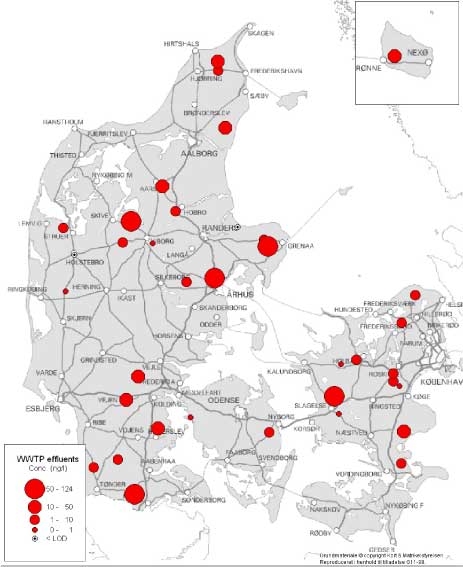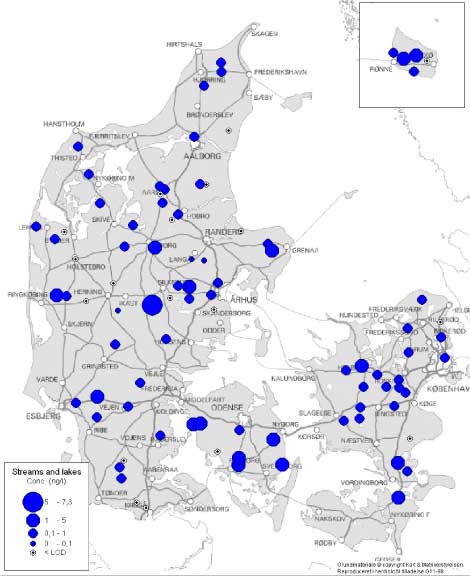|
| Front page | | Contents | | Previous | | Next |
Survey of Estrogenic Activity in the Danish Aquatic Environment
Summary and conclusions
Small, traditional wastewater treatment plants do not remove estrogens
The survey of estrogens in the Danish freshwater environment shows that modern treatment plants remove estrogens from waste water very efficient, and that this also applies to sand filters. In contrast, the
simple treatment plants have very low removal efficiency. This type of treatment plants are most common in the countryside, where septic tanks also will contribute with waste water of low treatment quality
regarding estrogens. In streams and lake without direct point sources the levels of estrogen activity are less than the levels causing hormone disruption in fish, whilst in the water bodies receiving waste water
concentrations above 1 ng/L are twice as frequent.
Why was this study initiated?
Concern was raised regarding the water quality when in 2000, a Danish field study showed up to 44% hormone disruption in populations of trout and roach in selected water bodies of the County of Århus.
A follow-up study in the Voel Bæk stream revealed that the observed anomalous sexual development in the trout population should be attributed not only to the localWWTP, but also to two field drains
receiving untreated sewage from single farmhouses.
A preliminary survey in 2002 of the contents of steroid hormones in Danish WWTPs effluents showed that steroid estrogens could be identified in effluents from 15 out of the 19 investigated plants.
International studies have suggested that the major contributors to hormone disruption are the estrogen hormones rather than industrial manmade substances called xenoestrogens. This was confirmed in a
limited Danish study in two WWTPs which revealed that the steroid estrogens could account for far more estrogenic activity than the analysed xenoestrogens; 80-94% and 90-95%, respectively.
The Danish EPA therefore wished to initiate a comprehensive study of the sources of and levels of estrogenic activity in the Danish freshwater environment using a biological screening methods and a
chemical anlysis programme focusing on the steroid estrogen hormones: estrone, estradiol and ethynylestradiol.
Box 1: The estrogens selected for analysis.
(The structurally very similar 17-estradiol is also analysed, but not shown) |
 |
 |
 |
| Estrone (E1) |
17β-Estradiol (E2) |
Ethynylestradiol (EE2) |
The survey
The survey included a total of 341 samples from 148 locations in the Danish freshwater environment including a range of possible pollution sources. All samples were analysed by the biological assay for both
free estrogens and total (see Box 2 on conjugation) estrogens giving a total of nearly 700 data sets. In addition, approx. 150 samples were analysed chemically for free estrogens and total (deconjugated)
estrogens. Thus, the complete survey comprises almost 1000 data sets from 18 environmental or source-related categories. Selected locations and effluents points were sampled 2-4 times over the year of
the study and some locations were sampled up and downstream of effluent points.
All samples were tested with the biological test for estrogenic activity, the YES assay, and approx.40% were analysed with chemical methods (GC-MS) for the three steroid estrogens shown in Box 1.
Box 2: Conjugation.
Estrogens are very fat soluble and cannot be effectively eliminated from the body with the urine unless they are chemically changed by the kidneys.
This is called conjugation and involves the attachment of a water soluble molecule either (glucoronide or sulphate). The conjugated form has no estrogenic activity
Once excreted the process can be reversed in the WWTP or the environment and the free active estrogen is formed again. In the study the conjugated estrogens are found as the difference between free and
total estrogens.
Conclusions
The results indicate that there is no widespread impact from estrogens in the Danish freshwater environment. However, downstream discharges of poorly treated wastewater to small receiving water courses,
or in case of overflow episodes, the resulting environmental concentration will probably exceed effect levels known from the scientific literature.
In 33% of the samples from the aquatic environment the estrogenic activity if present was below the limit of detection, LOD (= 0.05 ng/L). However, low estrogenic activity is found with the YES assay in
almost all types of freshwater environments in Denmark, but typically at concentrations lower than 1 ng/L.
In almost 70% of the water courses receiving effluents from WWTPs the level of estrogenic activity immediately downstream the discharge point was higher than the upstream activity. Further downstream of
the discharge point the estrogenic activity had decreased back to pre-discharge level. In the affected section of receiving water bodies the estrogenic activity was between one and five ng/L corresponding to
5-10 times the levels in background samples.
Results
For every sample two results from the YES assay exists (free and total estrogenic activity), and for the samples on which chemical analysis are performed, the four estrogen species are determined with and
without enzymatic treatment. The results of all field samples are shown in Figure 1.
Click here to see Figure 1.
Figure 1 A-D Presentation of all bioassay and chemical results for measurement of the total concentration of estrogens. Based on results in ng E2 equivalents/L.
Influents
Two to four influents in each WWTP category were sampled and the average estrogenic activity ranged from 20-90 ng/L. Most of the conjugated estrogens had already lost their conjugates since more than
90% of the estrogens were detected as free.
The quantitatively dominating steroid estrogen in wastewater is estrone followed by 17β-estradiol, for which the influent concentrations in this study are typically 20-30% of the total. The typical hormone in
anti-contraceptive pills ethynylestradiol occurs in more than half the influents, but in modest concentrations.
Effluents
At the modern(ised) WWTPs in categories A and B, activated sludge systems are installed for removal of nitrogen by nitrification/denitrification or nitrification only (MBND and MBN plants; Cat. A and B,
respectively). The estrogen levels in the effluents from these plants are only a few ng/L, as appears from the tables, and in a few cases in Cat. A, the levels are even below the detection limit. Also, the simpler
treatment technologies such as reed beds and biological sand filters perform well, in particular the latter (Cat. F) for which only one out of five effluent samples contained quantifiable levels of estrogenic
activity.

Figure 2 Map of the localisation of the WWTPs with indication of the estrogenic activity in their effluents. For the 12 WWTPs where more than one effluent sample were taken, the mean concentration has been used for the map. Based on results in ng E2 equivalents/L from total estrogenic activity measured in the YES assay.
In contrast to these, the effluents from the less advanced traditional treatment plants with biological-mechanical or only mechanical treatment of the wastewater contain high levels of estrogens. The effluent
levels are indistinguishable from the influent levels and, thus, these treatment technologies appear not to be capable of eliminating estrogens to any significant extent.
In more than 100 effluent samples from a broad range of WWTPs we only found EE2 in concentrations exceeding 1 ng/L in seven samples from six WWTPs representing all categories except B. Due to its
potency EE2 does occasionally account for a significant part (50%) of the estrogenic activity as measured in E2 equivalents, but most often approx. some 60-70% of the activity derives from E1 and
30-40% from E2.

Figure 3 Overview of estrogenic activity in Danish streams and lakes. For the locations where more than one sample have been taken, the mean concentration has been used for the map. Based on results in ng E2 equivalents/L from total estrogenic activity measured in the YES assay.
The sources in the open areas
Effluent from septic tanks and generally from isolated houses (category G) displayed relatively high estrogenic activities with weighted averages of more than 70 ng/L. In category H, drains from fields where
manure was applied approximately 2 weeks before the sampling, there are detections in 4 of the 8 samples, but in these samples the levels of total estrogens determined by the bioassay are low; from 0.1 -
1.1 ng/L and caused by estrone. It was not attributed to occurrence of the tracer for livestock. In category I, drains from fields amended with sludge before the first sampling in the spring of 2004, all five
samples contain quantifiable levels of estrogenic activity. One of the samples showed more than 30 ng/L estrogenic activity, but the sampled drain is suspected of also carrying sewage from a septic tank.
Stormwater retention basins did not show estrogenic activity.
The freshwater environment
In all sub-categories of freshwater aquatic environment (categories M-R) the weighted average levels of estrogenic activity are below 1 ng/L. Reference streams have the lowest level of all categories while
samples from reference lakes are found to exhibit estrogenic activity at or near the same level as that of presumably more affected lakes.
The "hit rate" i.e. the number of samples with quantifiable estrogenicity compared to the total number of samples is slightly higher in categories N and O (streams and lakes in areas with high density of
cattle/pigs) than in the other sub-categories. Thus, the overall results provide no indications of significant differences between the categories.
Geographical variation
It is not expected that any geographic variations in wastewater composition with impact on estrogenic activity, although parameters such as water hardness may vary. A demographic variation may be
expected e.g. due to a relatively younger population in urban areas with less women in menopause and increased use of anti-contraceptive pills, but if such an effect exist it is masked by the increased
occurrence of WWTPs of high efficiency.
In the freshwater environment the data give no indications of systematic regional differences due to geological conditions or differences in land use at the macro-level, except maybe for a slight indication of
generally higher estrogenicity levels in the streams and lakes of the island of Funen.
Seasonal variation
The variation in the estrogenic activity of the effluent does not appear related to the season, likewise free and total activity in the effluent samples are not related to season.
The samples taken winter-summer or spring-fall show that at the five sites for which winter-summer data are available, the summer samples are higher. The picture in the spring-fall samples is less clear, but
may be interpreted as highest level at the sampling time in the fall. There is no observable pattern in the free-to-total ratio of estrogens over the seasons.
The samples taken from sources in the open areas are by nature seasonally variable since they are linked to a seasonal activity such as the spreading of manure or sludge, or drainage systems primarily
running during rains. From the fish farm wit a production including rearing of sexually mature adults the samples from fall showed a higher estrogenic activity.
In the freshwater environment, no systematic pattern of seasonal variation is evident for samples taken in the spring and fall, but in the winter-summer sample pairs the summer samples appear to display
higher estrogenic activity. This could be caused by less water in the streams and lakes during the dry season rather than higher loads of estrogen.
Upstream and downstream
An analysis of a total of 46 data sets from 34 out of the 36 WWTP locations and their receiving streams (one data set missing, one discarded) shows that in 24 cases out of 35 where estrogenicity was
detectable (68%), the downstream level was higher than the upstream. In 5 cases the levels were equal, while in 6 cases (17%) the upstream concentration was the highest.
In one of the samples from sources in the open areas (fish farms) a difference between up and downstream was observed.
| Front page | | Contents | | Previous | | Next | | Top |
Version 1.0 Januar 2005, © Danish Environmental Protection Agency
|